LP76
| General Landscape Description: Irrigated pasture on a flat plain. | Mapped Soil Type: Fernihust Clay Loam. |
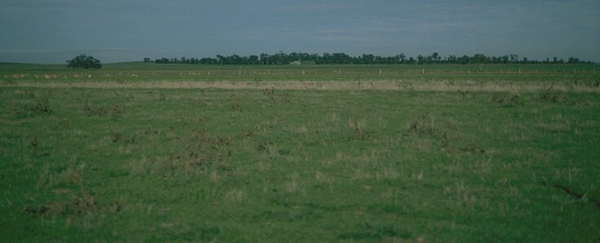 LP76 Landscape |
Soil Profile Morphology
Surface Soil
| A1 | 0-15 cm | Brown (10YR4/3); medium clay; firm surface condition; moderate fine polyhedral structure; firm consistence moist; pH 8.1; abrupt and smooth change to: | 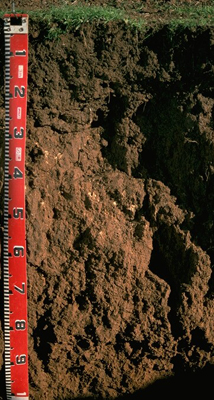 Lp76 Profile |
| Subsoil | |||
| B21 | 15-30 cm | Brown (7.5YR4/4); light medium clay; moderate medium blocky, breaking down to moderate fine polyhedral structure (smooth faced peds); strong consistence moist; pH 8.8; clear and wavy change to: | |
| B22 | 30-60 cm | Brown (7.5YR4/4); medium heavy clay; moderate coarse blocky structure; very firm consistence moist; contains very few (<2%) carbonate and silica nodules (2-3 cm in size) and few (2-10%) soft carbonates; pH 8.7; gradual and wavy change to: | |
| B23 | 60-80 cm | Strong brown (7.5YR5/6); medium heavy clay; moderate medium polyhedral, breaking down to fine polyhedral structure; very strong consistence moist; contains a few (2%) carbonate nodules (2-3 cm in size); pH 9.0; clear change to: | |
| B24 | 80+ cm | Strong brown (7.5YR5/8); light medium clay; well structured with small slickensides (smooth faced peds); firm consistence moist; pH 9.3. | |
Key Profile Features
- Accumulation of soft and hard carbonate and silica nodules in the subsoil.
- Vertic properties (ie. significant shrink-swell characteristics).
Key Profile Characteristics
pH | Salinity Rating | |||
Surface (A1 horizon) | moderately alkaline | low | non-sodic | none |
Subsoil (B21 horizon) | strongly alkaline | medium | sodic | none |
Deeper subsoil (at 80+ cm) | very strongly alkaline | very high | very strongly sodic | none |
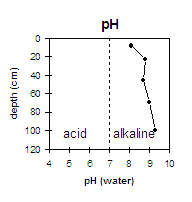 | 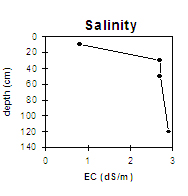 | 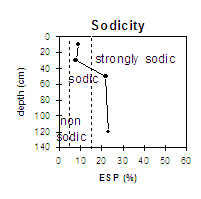 |
The surface is moderately alkaline. The subsoil is strongly alkaline becoming very strongly alkaline. | At 15 cm depth the subsoil salinity level becomes very high at about 70 cm. | The subsoil is sodic at 15 cm and becomes very strongly sodic at 60 cm. |
Whole Profile
- A very positive feature of this profile is that it has a very high inherent fertility throughout which is extremely beneficial to plant growth.
Surface (A) Horizon
- The surface has a high clay content with a visibly good organic mater content as well as the presence of worm casts. From laboratory testing, we found that indeed the organic content was high and the calcium levels were also high. These properties are very beneficial to plant development.
- The surface soil is non-sodic with no dispersion. The presence of moderate dispersion after remoulding indicates that structural degradation (e.g. surface sealing, increased cloddiness) may occur if the soil is cultivated or overstocked in a moist to wet condition. Also, raindrop action on bare surface soil may also promote dispersion and produce a hardsetting condition. Accordingly, surface cover should be maintained to protect against raindrop damage.
- The levels of total nitrogen measured at this pit site is low. However, this is best assessed by taking a bulked sample from across the paddock.
Subsoil (B) Horizons
- The strongly alkaline subsoil becomes very strongly alkaline at 80 cm and this suggests that some nutrients (e.g. manganese, zinc, iron, copper) may be poorly available to plants. Nutrient deficiencies can be assessed by plant tissue analysis. When choosing appropriate plant species, this high pH level should be considered when rooting depth is deeper than 15 cm.
- The subsoil is sodic with a low exchangeable calcium to magnesium ratio (i.e. 0.8) becoming strongly sodic at 60 cm and very strongly sodic at 85 cm. The soil only slightly disperses after remoulding no doubt due to the high levels of salt and is not likely to restrict root and water movement as significantly as would occur if the soil was not saline. Nevertheless, subsoil permeability will be low due to the low porosity of the clayey horizons. Deep ripping into the subsoil would help to break up the physical structural problems and the application of gypsum would help to neutralise the chemical sodic problems. This expensive option would firstly depend on expected crop yield and also on adequate rainfall, to wash the gypsum down the deep rips into the subsoil. Gypsum can also be added to the surface without deep ripping, but it would require more time to wash the gypsum down to the subsoil and less of it would probably make it.
- The salinity rating becomes moderate at about 15 cm depth and increases to a very high level at about 80 cm. These levels of soluble salts are likely to restrict the growth of salt sensitive plant species (e.g. faba beans, linseed, chickpeas and lupins).
- The deeper subsoil displays strong vertic properties (i.e. slickensides) which indicates that significant shrinking and swelling occurs with wetting and drying cycles. This may disturb the roots of some plant species and has engineering implications (e.g. disturbance to building foundations and fencelines.
Notes:
Profile described by Mark Imhof, Sonia Thompson and Paul Rampant, May 1995.


